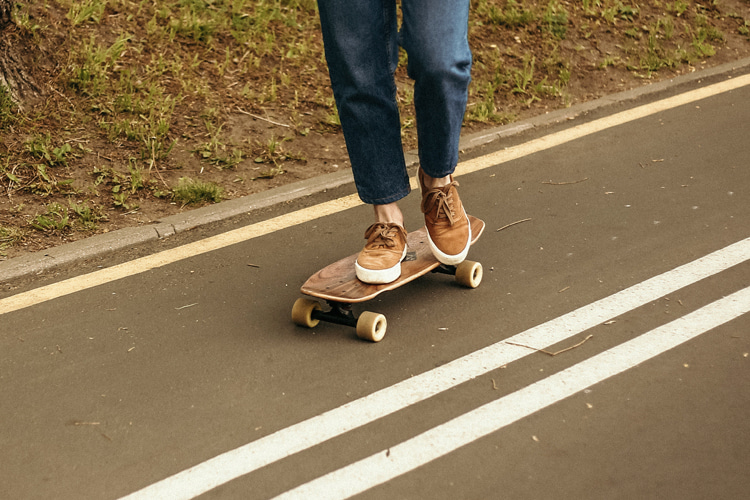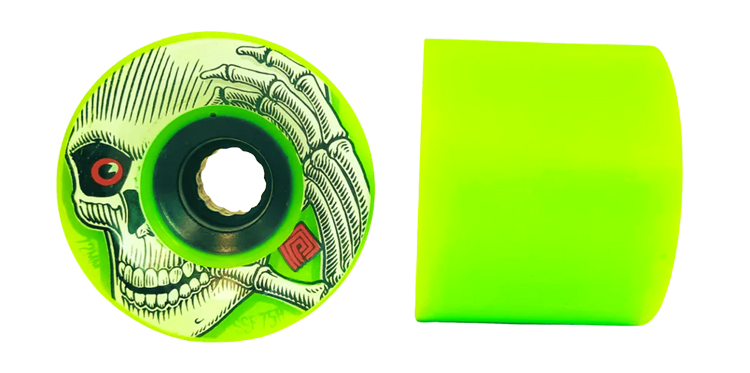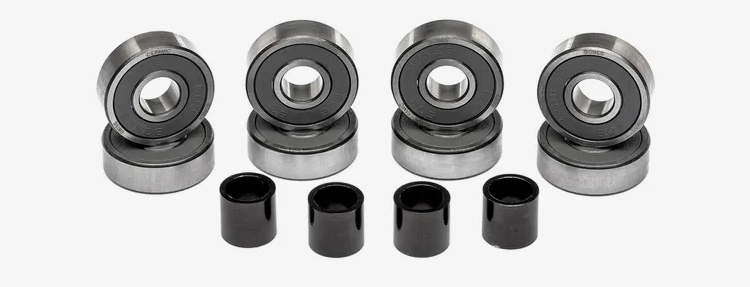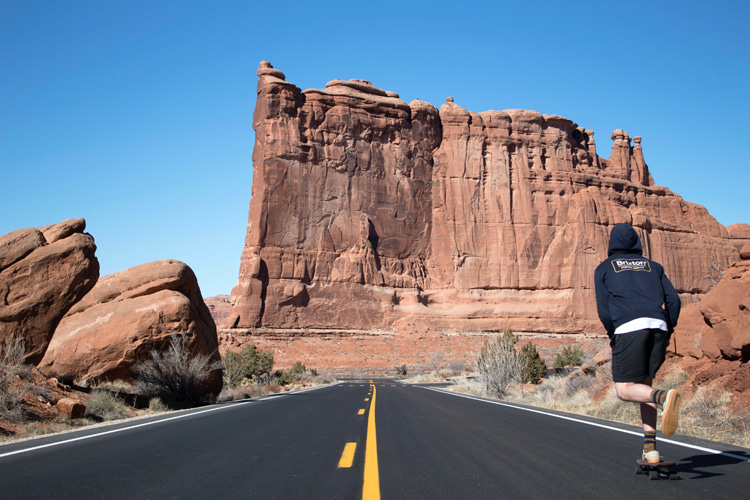If you're a skateboarder, you'll know that speed matters. But how fast can a skateboard actually go? And what makes the difference?
Those who can push on a skateboard and feel the wind on their face know that you need speed for nearly everything.
To time your tricks and maneuvers - slower or faster, depending on your goal - or simply to commute from one place to the other.
On average, a skateboard's speed can range from 5 to 12 miles per hour (8-19 kilometers per hour).
But there's more to it than just a simple number. The following factors impact the speed at which one can ride on a skateboard:
- Terrain;
- Riding Skills;
- Equipment;
Let's take a look at each one of them.
Terrain and Surfaces
The surface on which you ride your skateboard has a significant impact on your speed.
Asphalt, for example, offers good speed due to its smooth texture, but poor-quality asphalt can drastically reduce it, and pebbles can even make it dangerous.
Concrete, on the other hand, usually allows for a consistent and faster pace, depending on its finish.
Riding on the tarmac may slow down the skateboard due to its often rougher texture.
Flat surfaces permit steady cruising at average speeds, but going uphill can reduce speed significantly due to the challenge of gravity.
Downhill surfaces can be an adrenaline rush, increasing speed to thrilling or sometimes even dangerous levels.

Riding Skills and Experience
Your experience on the skateboard plays a vital role in how fast you can go.
Beginners are typically slower, as they're still learning the techniques and need to proceed with caution.
As a rider progresses to an intermediate level, speed increases with confidence and improved techniques.
Advanced riders have the potential to achieve higher speeds through mastery of pumping and slowing down techniques and an understanding of the terrain.
One thing's certain - the more comfortable and skilled a skater becomes, the faster they can travel.
Equipment
Types of Skateboards
Different types of skateboards offer various speed potentials.
The popsicle skateboard - the standard for street skating - offers moderate speeds.
Classic and downhill longboards are designed for speed and stability, making them faster than regular skateboards.
Cruisers are perfect for enjoying a smooth ride at moderate speeds.
Electric skateboards, believe it or not, take it to another level, with some models capable of speeds 70 miles per hour (112 kilometers per hour).
Wheels Size and Hardness
Skateboard wheels have a significant impact on the speed of a skateboard, influencing not only how fast it can go but also how smoothly and comfortably it rides.
Here's a breakdown of how skateboard wheels can affect speed:
- Diameter (Size)
- Larger Wheels: Generally, larger wheels roll faster and cover more ground with each rotation. They are often chosen for speed and are more suitable for cruising and long rides;
- Smaller Wheels: Smaller wheels are generally slower and provide more stability, making them popular for tricks and technical skateboarding;
- Durometer (Hardness)
- Harder Wheels: Typically faster and best suited for smooth surfaces, harder wheels slide more easily and offer less grip;
- Softer Wheels: Softer wheels absorb more vibrations, offering a smoother ride, especially on rough or uneven surfaces. They grip the road better but might be slower compared to harder wheels;
- Contact Patch (Surface Area Touching the Ground)
- Wider Contact Patch: More surface area in contact with the ground usually translates to more grip but can create more friction, slightly reducing speed;
- Narrower Contact Patch: Less surface area in contact with the ground means less friction, potentially increasing speed, but may reduce stability and grip;
- Wheel Shape and Profile
- Different wheel shapes can affect how the skateboard handles different terrains and thus indirectly influence speed. Sharp-edged wheels might provide more grip, while rounded edges might offer more slide and speed;
- Material and Construction
- High-quality polyurethane wheels tend to offer a better balance of grip, durability, and speed. The specific formulation can influence how fast the wheels are;
- Terrain Compatibility
- The choice of wheel hardness and size should align with the surface you intend to skate on. For example, softer wheels might be slower on smooth surfaces but faster on rough terrains compared to hard wheels, as they can roll over obstacles more easily;
- Weight of the Rider
- Heavier riders might find softer wheels more suitable as they compress more under weight, increasing the contact patch and grip. Lighter riders might find harder wheels more advantageous for speed;
- Maintenance and Wear
- Worn-out wheels may lose their efficiency, slowing down the skateboard. Regular inspection and proper maintenance help in maintaining optimal speed. Ultimately, it's always a compromise between stability, safety, maneuverability, and speed;

Bearings
Skateboard bearings play a crucial role in determining the speed of a skateboard.
They allow skateboard wheels to spin on the axles of the trucks.
High-quality bearings reduce friction and allow the wheels to spin more freely, resulting in increased speed.
They are generally made with better materials and precise manufacturing techniques, which reduce rolling resistance.
Bearings need proper lubrication to function smoothly.
Properly lubricated bearings reduce friction between the balls inside the bearing and their races, enabling a smoother and faster ride.
Lack of lubrication can cause the bearings to become slow or even seize.
Dirt, grime, and other debris can get into the bearings and create additional friction, slowing down the skateboard.
Regular cleaning and maintenance keep the bearings in top condition, allowing them to perform at their best.
Bearings are often rated by the ABEC scale, which measures precision and accuracy.
While a higher ABEC rating might imply better manufacturing precision, it doesn't necessarily mean a noticeable increase in speed for the average skateboarder.
Some argue that the ABEC rating is more relevant for high-speed machinery than skateboarding.
Bearings made from certain materials like ceramic are known for reduced friction and better heat handling, potentially offering higher speeds compared to traditional steel bearings.
Ceramic bearings are also less prone to corrosion, extending their life and maintaining their performance over time.
Over time, these little balls can wear down, leading to increased friction and reduced speed.
Regular inspection and replacement of worn bearings can maintain optimal performance.
Some bearings, like Swiss ceramics, are specifically designed with skateboarding in mind.
They often feature special materials, design, or lubrication to maximize speed and performance.

Real-Life Speed Examples
Actual speeds can vary widely based on the situations mentioned above.
Nevertheless, here's a list of several real-life average skateboarding speed events and situations:
- Intermediate skateboarders riding soft wheels: 7.5 miles per hour (12 kilometers per hour);
- Short commute to school: 8 to 12 miles per hour (12-19 kilometers per hour);
- Medium-run cruise to the beach: 7 miles per hour (11 kilometers per hour);
- Long ride on a flat surface: 5 and 8 miles per hour (8-12 kilometers per hour);
- Pushing easily on a longboard: 8 to 9 miles per hour (12-14 kilometers per hour);
- Riding quality ceramic bearings: 7.5 to 12 miles per hour (12-19 kilometers per hour);
- Experienced riders going downhill: 50-90 miles per hour (80-144 kilometers per hour);
Peter Connolly holds the record for the fastest downhill longboarding speed.
He achieved a speed of 91.17 miles per hour (146.73 kilometers per hour) on September 16, 2017, in Quebec, Canada.
The record-setting feat was part of the Les Éboulements event in the Charlevoix region.
